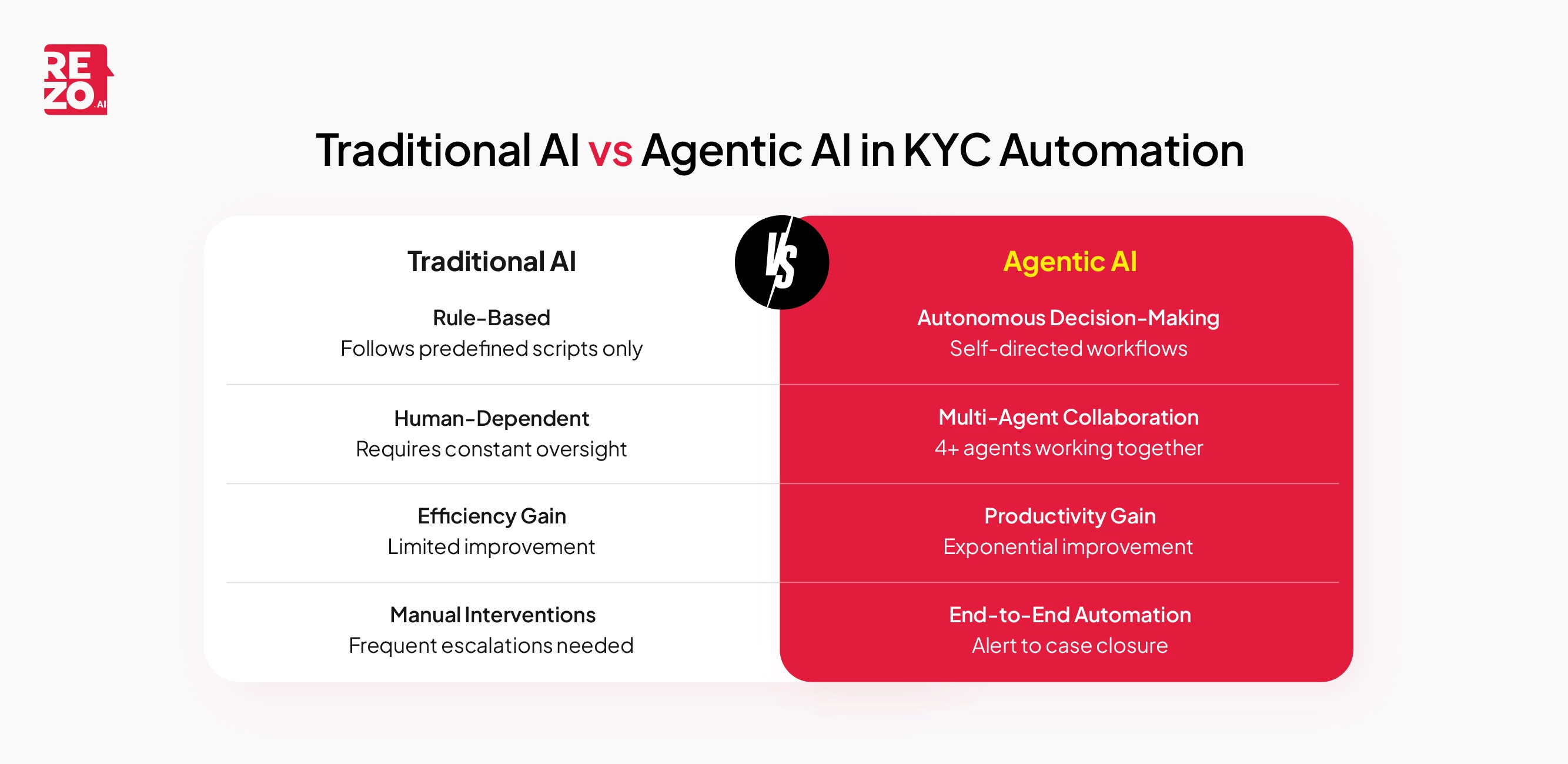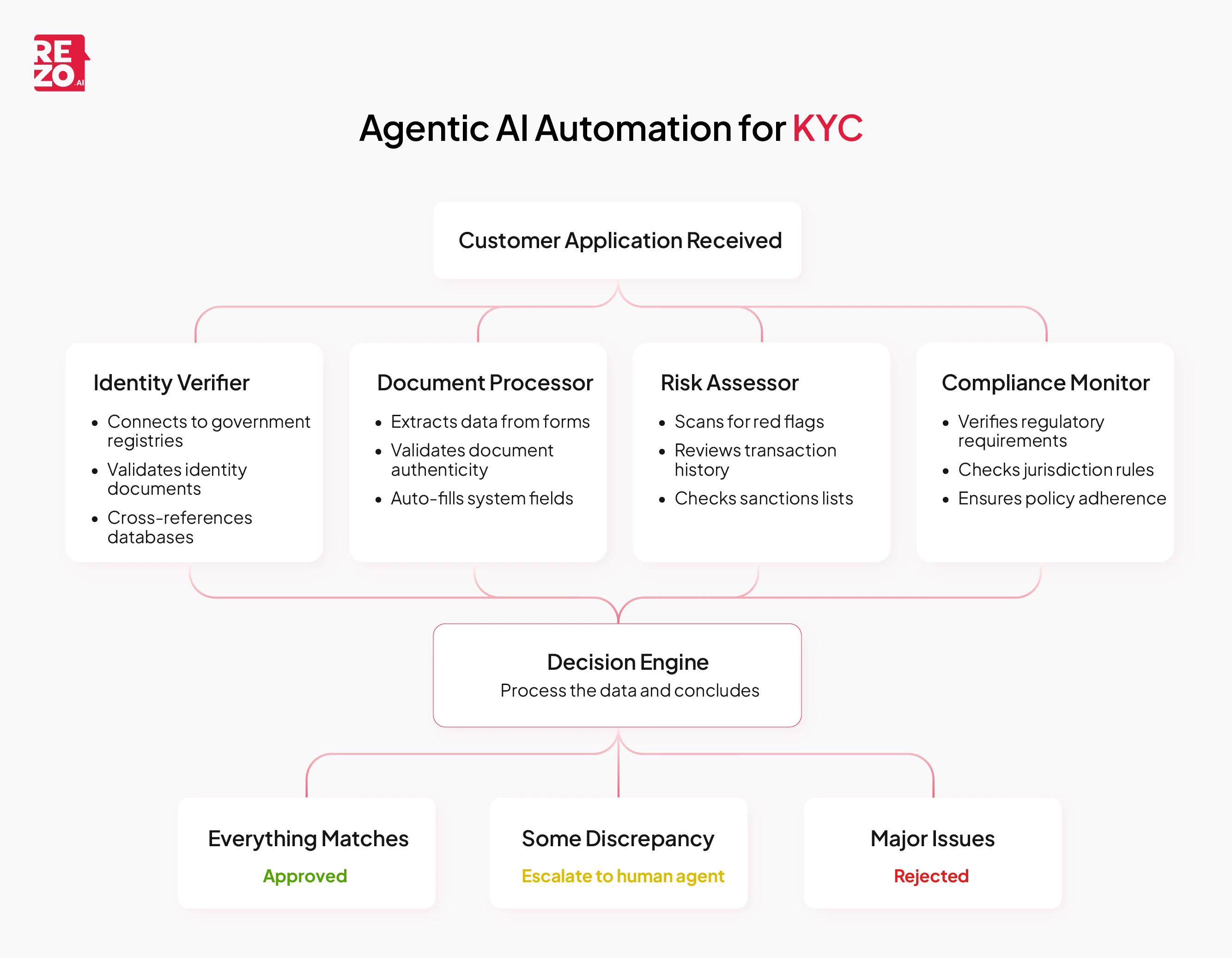
Automating KYC Compliance: How Agentic AI is Transforming Banking Operations

Automating KYC Compliance: How Agentic AI is Transforming Banking Operations


Financial institutions spend approximately $37.1 billion annually on Anti-Money Laundering and Know Your Customer (AML-KYC) compliance functions. Yet despite this massive investment, the average KYC review for a corporate client costs $2,598 and takes 95 days to complete. Moreover, majority of banks identify manual workloads as a major operating challenge.
The traditional approach to KYC compliance in the banking sector is broken. Manual processes, periodic reviews, and fragmented systems create a perfect storm of high costs, operational inefficiency, and compliance risk. But a new solution is emerging that promises to fundamentally transform how banks handle KYC updates and compliance: agentic AI in banking.
Unlike traditional AI and automation that simply speeds up manual tasks, agentic AI systems operate autonomously, executing end-to-end workflows, making informed decisions, and continuously learning. These advanced AI technologies enable banks to process structured and unstructured data while delivering unprecedented operational efficiency. McKinsey reports that agentic AI is driving productivity gains of 200-to-2,000% in compliance domains like KYC/AML by autonomously executing complete workflows rather than just assisting humans.
In this article, we explore how agentic AI model is revolutionizing KYC compliance in the BFSI sector, the quantifiable benefits banks are already achieving with AI in banking, and what this transformation means for compliance professionals and financial institutions.
What is the KYC Compliance Challenge in BFSI?
The Financial Burden of Traditional KYC
The cost of KYC compliance has reached unsustainable levels. Reports say that majority of corporate and institutional banks pay a staggering amount of over $3000 per client review.
The resource allocation is equally staggering. According to McKinsey banks commonly assign up to 10 to 15 percent of their full-time equivalents to KYC/AML activities alone. More than half of financial institutions spend between over 5 months sometimes on client KYC reviews.
Operational Inefficiencies and Compliance Risks
The challenges extend beyond direct financial costs. The KYC process often remains highly manual with repetitive tasks, which makes it expensive and prone to errors. A striking number of banks in the banking industry indicate AI technologies as the area requiring the greatest financial commitment in AML/KYC compliance management.
The compliance risk is substantial. Banks paid hefty fines globally due to non-compliance with Anti-Money Laundering, Know Your Customer, and sanctions regulations. Yet despite increasing spending by up to 10 percent a year in some advanced markets between 2015 and 2022, the financial services industry detects only about 2 percent of global financial crime flows.
The Periodic Review Burden
Regulatory requirements mandate periodic KYC reviews as part of ongoing due diligence in compliance frameworks. These reviews can be undertaken annually, while three-year and five-year reviews are also common, with event-driven actions prompting additional reviews.
Standard practices range from traditional periodic refresh cycles (one-, two-, and three-year refreshes or one-, three-, and five-year refreshes) to selective, trigger-based models for lower-risk customers, with many institutions employing a combination of the two. This creates a continuous compliance burden that traditional manual processes struggle to manage efficiently.
For banks seeking to optimize these processes, implementing agentic AI offers a path toward automated compliance monitoring and 24/7 compliance support.

Understanding Agentic AI for KYC Automation
What Makes Agentic AI Different?
Traditional automation in banking has focused on robotic process automation (RPA) and gen AI that follows predefined rules and requires significant human intervention. Agentic AI represents a fundamental shift in AI capabilities. These AI agents operate autonomously, make decisions, and execute complete workflows and drive operational efficiency without constant human oversight, leveraging advanced AI models and machine learning algorithms.
The difference in performance is dramatic. While traditional and generative AI systems might improve efficiency, agentic AI enables AI agents to carry out tasks and make decisions autonomously, automating client onboarding activities including KYC checks and refreshes, transaction monitoring, and sanctions or fraud detection investigations from alert to case closure.
Banks are integrating AI technologies to transform KYC, targeting cost reductions while improving regulatory compliance, reducing manual work, and enhancing customer satisfaction.
Multi-Agent Collaboration for Complex Workflows
One of the most powerful aspects of agentic AI is multi-agent collaboration where multiple AI agents work together. In loan onboarding for investment banking and retail banking, for example, one agent verifies Know Your Customer information, another pulls credit data, a third scans for red flags and cyber threats, and a fourth generates a tailored pricing offer. These AI agents can communicate with other AI agents to enhance efficiency and deliver hyper-personalized services.
Understanding the different types of AI agents and their specific automation capabilities is essential for implementing effective KYC solutions.
Real-Time Monitoring and Automated Updates
Unlike periodic review models that create snapshots in time, AI powered automation enables continuous monitoring and risk management. Automated KYC solutions flag and highlight material changes in controlling individuals, entities, and shareholders, ensuring that critical updates are not overlooked while maintaining data integrity and data privacy.
Corporate customers’ information is updated automatically by connecting to company registries, downloading the most up-to-date documentation, and extracting Ultimate Beneficial Owner (UBO) information. Automated business KYC solutions keep pace with the regulatory environment and changing market dynamics by integrating new types of company documents specific to each jurisdiction, ensuring ongoing compliance and reducing the risk of penalties or non-compliance issues.

Rapid Industry Adoption and Market Growth
Current Adoption Rates
The financial sector is moving quickly with AI adoption for compliance. Reports state that currently, 62% of financial institutions already use AI and ML in some capacity for AML activities, demonstrating significant AI integration across the banking industry, and this is expected to increase to 90% in 2025. In India specifically, BFSI leaders have already piloted agentic AI tools as part of their AI strategy to enhance underwriting, fraud detection, and customer service while managing customer data in a responsible manner.
Looking ahead, most of the KYC onboarding for new customers will be automated in 2025, using biometric identification, digital identity verification, and enhanced data analytics driven by AI algorithms. Additionally, AML/KYC procedures are expected to be conducted via blockchain-based systems in 2025.
Market Recognition and Growth
The potential has not gone unnoticed by industry leaders and regulatory bodies. Bank of America noted that agentic AI may alter bank operations and “spark a corporate efficiency revolution” through technological innovation. Citigroup went further, suggesting it “could have a bigger impact on the economy and finance than the internet era,” highlighting the business value of AI initiatives.
The market is responding accordingly. Reports suggest by mid-2025, the global RegTech market is projected to exceed $22 billion, growing at a CAGR of 23.5%, driven by AI in banking development and digital transformation across financial services.
What are the use cases of Agentic AI in KYC and Compliance?
Automated KYC Onboarding
The most immediate application of agentic AI in banking is in customer onboarding for new customers. AI-powered KYC transformations analyzing high volume of data have achieved a four-minute onboarding process while increasing fraud detection rates and identifying fraudulent transactions.
Some clients report a 40% increase in efficiency and competitive advantage compared to traditional methods when using AI-driven KYC solutions.
The technology leverages biometric identification, digital identity verification, and enhanced data analytics to process applications in minutes rather than days or weeks, streamlining operations across the financial sector. This is particularly valuable for chatbots in banking and virtual assistants that provide round-the-clock customer support and instant account opening capabilities while delivering personalized services.
From Periodic to Perpetual KYC
A fundamental shift is occurring in how banks approach ongoing due diligence. Perpetual KYC, or pKYC, is a process that responds to changes as soon as they are made, rather than a time-based review of information. It is proactive rather than reactive, which means its ongoing due diligence approach is dynamic and refreshed based on response to key triggering events.
Perpetual KYC often involves the use of advanced technologies such as artificial intelligence, generative AI, and machine learning models to automate the detection of events and changes, facilitating a more efficient and proactive approach to customer due diligence and risk assessments. This shift from periodic snapshots to continuous monitoring represents one of the most significant transformations in compliance practices enabled by AI capabilities.
Banks implementing predictive analytics for banking and AI driven predictive analytics can identify patterns and trends in real-time, analyzing vast amounts of data to enable proactive compliance management and informed decision making processes.
Automated Document Processing
Document collection, verification, and processing represent a significant portion of KYC workload with many repetitive tasks. Agentic AI in banking automates this end-to-end using large language models and data management systems. The system connects to company registries, downloads current documentation, and extracts relevant information without human intervention, enabling banks to process vast amounts of structured and unstructured data.
Moreover, these AI models adapt to regulatory changes by integrating new types of company documents specific to each jurisdiction, ensuring ongoing compliance across multiple markets. This is particularly crucial for institutions operating across borders with varying regulatory requirements and working with existing systems.
AML Transaction Monitoring
Beyond initial onboarding, agentic AI excels at ongoing transaction monitoring for fraud prevention. The AI in banking models automate the entire process from alert generation through investigation to case closure using predictive AI, generative AI and real-time analysis. This includes sanctions screening, fraud detection, identifying fraudulent transactions, and suspicious activity reporting while maintaining compliance management.
The multi-agent approach is particularly effective here, with different AI agents specializing in various aspects of risk assessment, credit data analysis, red flag identification for investment research, and pricing optimization for financial products.
For institutions managing collections and recovery processes, leveraging AI for debt collection while maintaining compliance creates operational efficiencies across the entire customer lifecycle.

What is the ROI of AI in banking?
Dramatic Cost Reductions
The financial impact and business value of agentic AI implementation is substantial for the banking sector. According to some industry reports AI powered automation can deliver up to 70% operational expenditure reduction in BFSI organizations through integrating AI technologies. More specifically, banks implementing comprehensive AI solutions report cost reduction of 40-60% in processing-intensive operations within the first year of deployment.
Financial institutions achieve OpEx reduction of 45-65% in compliance-related activities through comprehensive automation, while document-heavy operations can achieve OpEx reduction of 50-70%, demonstrating clear monetary value.
For individual institutions, this translates to concrete savings as part of their business strategy. Starting from a baseline where the average corporate KYC review costs $2,598 and 21% of reviews exceed $3,000, a 50% cost reduction target represents millions in annual savings for leading banks.
Time and Efficiency Gains
The time savings are equally impressive. Moving from an average 95-day KYC review cycle to near real-time or four-minute processing represents a 99%+ reduction in cycle time. According to FinTech Global the 40% efficiency increase reported by clients using AI-driven KYC solutions enables banks to process significantly more reviews with the same or fewer resources.
Institutions can reallocate the 10-15% of FTEs currently dedicated exclusively to KYC/AML toward higher-value activities such as complex case investigations and strategic compliance initiatives.
How agentic AI makes scalability effortless for CX teams applies equally to compliance teams, enabling them to handle increased volumes without proportional headcount increases.
Enhanced Compliance and Risk Mitigation
Beyond cost and time savings, agentic AI in banking sector significantly improves compliance effectiveness. The increase in fraud detection rates demonstrates superior performance compared to traditional methods. This represents a dramatic improvement over the current baseline where reportedly only 2% of financial crime flows are detected.
The risk mitigation extends to penalty avoidance. With banks having paid approximately over $25 billion globally in AML/KYC fines, even a modest reduction in compliance failures generates substantial value. Automated compliance systems generate regulatory reports in real-time, reducing the need for dedicated compliance teams while ensuring accuracy and timeliness.
2Automation helps companies evaluate regulatory data and ensure compliance with applicable laws, minimizing the chances of monetary penalties and reputational damage.
How to Implement Agentic AI in Banking Operations?
Technology Foundation
Successful AI integration requires the right technology stack and AI strategy. Intelligent automation integrates technologies like robotic process automation, artificial intelligence, and machine learning to automate and optimize complex processes while working with existing systems. Modern platforms like Rezo AI provide the infrastructure for multi-agent collaboration using Agentic AI in banking sector and machine learning models.
The system must connect to core banking systems, company registries, CRM platforms, document management systems for risk management, wealth management, and regulatory reporting tools to function effectively. Real-time data processing capabilities and secure data storage are essential for maintaining compliance with GDPR, CCPA, and other regulations while ensuring data privacy and data integrity for customer or client data and financial products.
Starting with Pilots
The data shows that a pilot approach is common and effective for AI initiatives. With 64% of BFSI leaders in India having piloted agentic AI tools as part of their AI adoption strategy, the path to adoption is clear: start small, prove value, then scale.
Begin with high-volume, routine KYC reviews where the ROI is clearest and risk is lowest. Focus on automating document collection and verification first using AI tools, then expand to more complex risk assessment and decision-making processes that require human intelligence. Measure results rigorously, comparing cost per review, cycle time, accuracy rates, and compliance metrics against baseline performance to demonstrate competitive advantage.
Change Management and Governance
The transition to agentic AI in banking sector requires careful change management and ethical AI development practices. With banks citing manual workloads and repetitive tasks as a major challenge, staff are often overburdened and may welcome automation. However, clear communication about how AI augments human intelligence rather than replaces human expertise is essential for wealth management, investment banking, and retail banking teams.
Establish clear governance protocols including escalation paths for complex cases, human oversight for high-risk decision making processes, regular audits of AI decisions, and continuous monitoring of performance metrics. This ensures that AI powered automation enhances rather than compromises compliance while enabling banks to maintain regulatory compliance and ethical AI development standards.
For institutions managing multiple customer touchpoints, improving customer satisfaction in banking with conversational AI creates consistency across KYC onboarding and ongoing service interactions.

The Future: Autonomous Compliance Operations
The trajectory toward digital transformation is clear. With AI/ML adoption in AML activities expected to reach 90% by 2025, up from 62% currently, we are witnessing a fundamental transformation across the financial services industry. The shift from periodic to perpetual KYC represents the future of compliance operations, enabled by AI technologies and embedded finance capabilities.
Looking ahead, we can expect fully autonomous compliance operations where AI systems continuously monitor customers, automatically detect triggering events, execute required reviews, generate regulatory reports, and escalate only exceptional cases requiring human intervention to human review. Cross-border coordination will improve as AI agents integrate data across jurisdictions, and industry-wide data sharing standards will enhance collective defense against financial crime and cyber threats while leveraging AI for enhanced efficiency.
The combination of agentic AI voice agents for customer engagement with automated KYC processes will create seamless experiences where customer interactions, identity verification, and ongoing monitoring operate as a unified, intelligent system.
Financial institutions that remain dependent on manual processes, periodic reviews, and fragmented systems will find themselves at a competitive disadvantage. The institutions thriving in 2025 and beyond will be those that embrace autonomous, AI-powered compliance operations today.
Conclusion
The case for agentic AI in banking for KYC compliance is compelling. Financial institutions currently spend $37.1 billion annually on KYC/AML compliance, with individual reviews costing up to $3,000 and taking 95 days. Agentic AI offers a path to 50-70% cost reductions, 99%+ reduction in processing time, 40-45% improvements in operational efficiency and fraud detection, and dramatically better compliance outcomes that deliver monetary value.
The technology has matured beyond pilot phase. With a great percentage of institutions already using AI/ML for AML and AI usage is expected to reach 90% by 2025, the question is no longer whether to implement agentic AI but how quickly you can deploy it to remain competitive in the banking industry.
The institutions that will lead the next decade of banking are those that recognize compliance not as a cost center to be minimized but as an opportunity to be optimized through intelligent automation and integrating artificial intelligence. Agentic AI makes this possible, transforming KYC from a burden into a competitive advantage through streamlining operations and delivering accurate and personalized services.
For compliance officers, risk managers, and banking operations leaders, the time to act is now. Evaluate agentic AI platforms and AI tools, start pilot programs to analyze vast amounts of data, and begin your journey toward autonomous compliance operations. The future of KYC in AI in banking is here, and it is autonomous, intelligent, and transformative.
Frequently Asked Questions
1. How does agentic AI in banking ensure data privacy and security when handling sensitive customer information?
Agentic AI systems incorporate built-in encryption, role-based access controls, and compliance with regulations like GDPR and CCPA. All automated decision making processes include audit trails and explainability features, ensuring transparency and accountability while protecting sensitive customer data and maintaining data privacy throughout the KYC process.
2. Can small and mid-sized banks implement agentic AI, or is it only for large institutions?
Agentic AI solutions are increasingly accessible to banks of all sizes in the banking sector through cloud-based platforms and scalable pricing models. Many vendors offer modular implementations that allow smaller institutions to start with specific use cases like document verification before expanding to comprehensive automation, enabling banks to achieve business value at any scale.
3. What happens when agentic AI encounters a complex case it cannot resolve autonomously?
The AI model automatically escalates complex or high-risk cases to human compliance officers through predefined governance protocols, balancing AI capabilities with human intervention. These escalation paths ensure that edge cases, regulatory exceptions, and unusual patterns receive appropriate human expertise and human intelligence before final informed decisions are made.
4. How long does it typically take to see ROI after implementing agentic AI for KYC?
Most banks observe measurable ROI and financial value within 3-6 months of pilot implementation, with cost savings and operational efficiency gains becoming evident as the AI agents processes its first batches of reviews. Full enterprise deployment typically takes 12-18 months, but early wins in pilot programs help justify continued investment and scaling of AI initiatives.
Frequently Asked Questions (FAQs)

Take the leap towards innovation with Rezo.ai
Get started now














